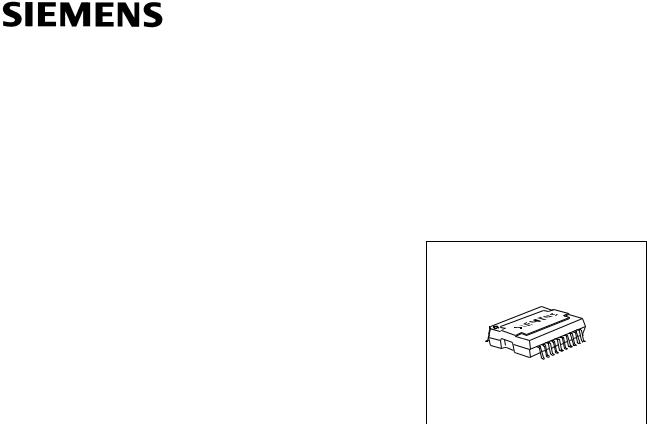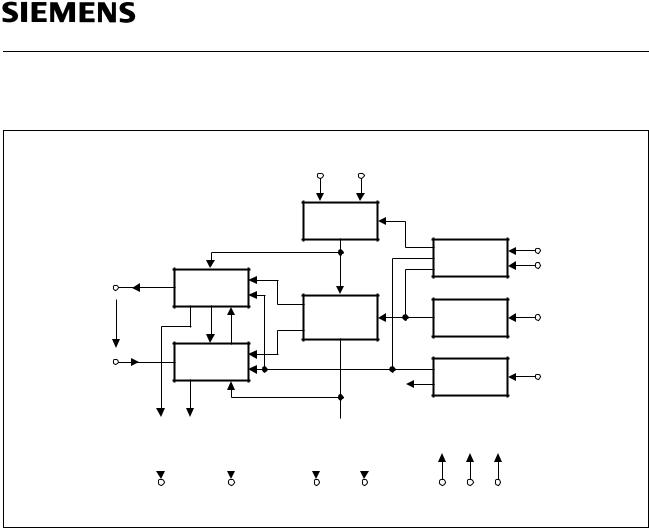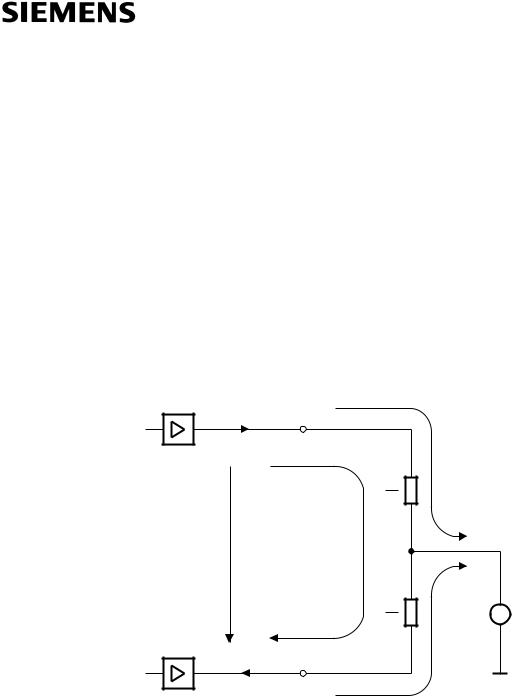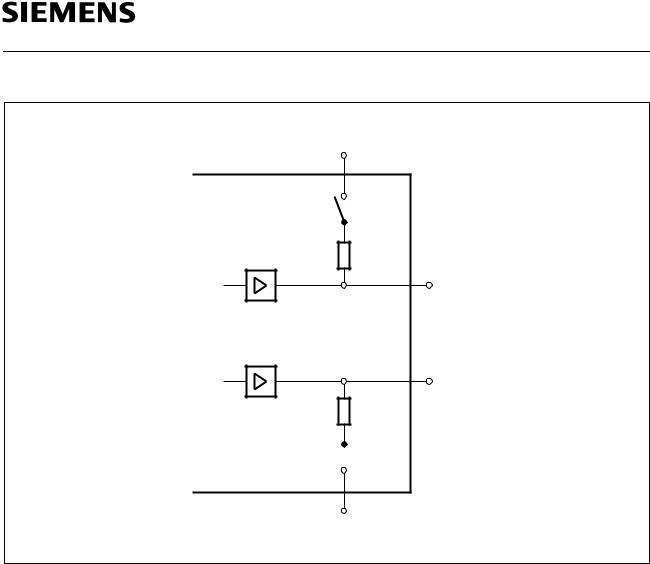Siemens PEB4065, PEF4065 Datasheet

ICs for Communications
High Voltage Subscriber Line IC
HV-SLIC
PEB/F 4065 Version 3.0
Data Sheet 03.98
DS 1
|
|
|
|
|
|
|
|
|
/ |
|
|
|
|
|
|
|
|
|
e |
|
|
|
|
|
|
|
|
d |
|
|
|
|
|
|
|
|
. |
|
|
|
|
|
|
|
|
s |
/ |
||
|
|
|
|
|
n |
|
|||
|
|
|
|
e |
|
o |
|
||
|
.siem |
|
|
r |
|||||
|
ct |
|
|
||||||
|
|
|
|
u |
|
|
|
|
|
|
|
|
d |
|
|
|
|
|
|
|
w |
n |
|
|
|
|
|
|
|
http://ww |
o |
|
|
|
|
|
|
|
|
|
ic |
|
|
|
|
|
|
|
|
m |
|
|
|
|
|
|
|
||
|
|
|
|
|
|
|
|
||
Se |
|
|
|
|
|
|
|
|
|
PEB/F 4065 |
|
|
Revision History: |
Current Version: 03.98 |
|
|
|
|
Previous Version: |
01.96 |
|
|
|
|
Page |
Page |
Subjects (major changes since last revision) |
(in previous |
(in current |
|
Version) |
Version) |
|
|
|
|
|
|
|
|
|
|
SLICOFI® is a registered trademark of SIEMENS AG.
For questions on technology, delivery and prices please contact the Semiconductor Group Offices in Germany or the Siemens Companies and Representatives worldwide: see our webpage at http:/ /www.siemens.de/Semiconductor/address/address.htm.
Edition 03.98
Published by Siemens AG, HL SP,
Balanstraße 73,
81541 München
© Siemens AG 1998.
All Rights Reserved.
Attention please!
As far as patents or other rights of third parties are concerned, liability is only assumed for components, not for applications, processes and circuits implemented within components or assemblies.
The information describes the type of component and shall not be considered as assured characteristics. Terms of delivery and rights to change design reserved.
Due to technical requirements components may contain dangerous substances. For information on the types in question please contact your nearest Siemens Office, Semiconductor Group.
Siemens AG is an approved CECC manufacturer.
Packing
Please use the recycling operators known to you. We can also help you – get in touch with your nearest sales office. By agreement we will take packing material back, if it is sorted. You must bear the costs of transport.
For packing material that is returned to us unsorted or which we are not obliged to accept, we shall have to invoice you for any costs incurred.
Components used in life-support devices or systems must be expressly authorized for such purpose!
Critical components1 of the Semiconductor Group of Siemens AG, may only be used in life-support devices or systems2 with the express written approval of the Semiconductor Group of Siemens AG.
1A critical component is a component used in a life-support device or system whose failure can reasonably be expected to cause the failure of that life-support device or system, or to affect its safety or effectiveness of that device or system.
2Life support devices or systems are intended (a) to be implanted in the human body, or (b) to support and/or maintain and sustain human life. If they fail, it is reasonable to assume that the health of the user may be endangered.

PEB/F 4065
Table of Contents |
Page |
|
1 |
Overview . . . . . . . . . . . . . . . . . . . . . . . . . . . . . . . . . . . . . . . . . . . . . . . |
. . . .4 |
1.1 |
Features . . . . . . . . . . . . . . . . . . . . . . . . . . . . . . . . . . . . . . . . . . . . . . . . |
. . .4 |
1.2 |
Functional Description . . . . . . . . . . . . . . . . . . . . . . . . . . . . . . . . . . . . . . |
. . .5 |
1.3 |
Pin Description . . . . . . . . . . . . . . . . . . . . . . . . . . . . . . . . . . . . . . . . . . . |
. . .9 |
2 |
Electrical Characteristics. . . . . . . . . . . . . . . . . . . . . . . . . . . . . . . . . . . |
. .11 |
2.1 |
Absolute Maximum Ratings . . . . . . . . . . . . . . . . . . . . . . . . . . . . . . . . . . |
. .11 |
2.2 |
Operating Range . . . . . . . . . . . . . . . . . . . . . . . . . . . . . . . . . . . . . . . . . . |
. .12 |
2.3 |
Thermal Resistances . . . . . . . . . . . . . . . . . . . . . . . . . . . . . . . . . . . . . . . |
. .12 |
2.4 |
Electrical Parameters . . . . . . . . . . . . . . . . . . . . . . . . . . . . . . . . . . . . . . |
. .13 |
2.5 |
AC-Characteristics . . . . . . . . . . . . . . . . . . . . . . . . . . . . . . . . . . . . . . . . . |
. .18 |
3 |
Package Outlines . . . . . . . . . . . . . . . . . . . . . . . . . . . . . . . . . . . . . . . . . |
. .29 |
Semiconductor Group |
3 |
1998-03-01 |

High Voltage Subscriber Line IC |
PEB/F 4065 |
HV-SLIC |
|
Version 1.1 |
SPT |
1 Overview
The High Voltage Subscriber Line IC PEB 4065 is a rugged and reliable interface between the telephone line and the SLICOFI, a low voltage Subscriber Line Interface and Codec Filter IC. It is fabricated in a Smart Power Technology offering a breakthrough voltage of at least 170 V.
The PEB 4065 |
provides battery feeding |
between |
P-DSO-20-5 |
– 24 V and – 80 |
V and internal ringing injection with a |
|
|
|
|||
differential ring |
voltage up to 85 Vrms. In |
order to |
|
achieve these high amplitudes an auxiliary positive battery voltage is used during ringing. This voltage can also be applied in order to drive very long telephone lines.
The SLIC is designed for a voltage feeding – current sensing line interface concept and provides sensing of transversal and longitudinal current on both wires.
A power-down mode offers reduced power consumption at full functionality; in the power denial mode the device is switched off turning the line outputs to a high impedance state.
1.1Features
•High voltage line feeding
•Internal ring and metering signal injection
•Sensing of transversal and longitudinal line current
•Reliable 170 V Smart Power Technology
•Battery voltage – 24 V … – 80 V
•Boosted battery mode for long telephone lines and up to 85 Vrms balanced ringing
•Polarity reversal
•Small P-DSO-20-5 power package
Type |
Ordering Code |
Package |
|
|
|
PEB/F 4065 |
on request |
P-DSO-20-5 |
|
|
|
Semiconductor Group |
4 |
1998-03-01 |

PEB/F 4065
Overview
1.2Functional Description
|
|
VH |
BGND |
|
|
|
|
|
Supply |
|
|
||
|
|
Switch |
|
|
||
|
|
|
VHINT |
Control |
C1 |
|
|
Ι a |
|
C2 |
|||
|
|
|
|
|||
RING |
Buffer |
|
|
|
||
|
|
|
|
|||
V |
|
Differential |
V/I Converter |
V2W |
||
ab |
I/V-Converter |
|||||
|
|
|
||||
TIP |
Ι b |
Buffer |
|
|
|
|
|
|
Reference |
PDN |
|||
|
|
|
|
|||
Current sensor |
|
|
VBAT |
|||
|
|
Supply |
||||
|
|
|
|
|
||
|
|
|
|
|
|
|
|
|
|
|
|
|
|
Ι T Ι L VBAT VBIM AGND VSS VDD ITB10371
Figure 1 Block Diagram
The PEB 4065 supports AC and DC control loops based on feeding a voltage Vab to the line and sensing the transversal line current Iab (Figure 2).
It converts a unipolar input voltage V2W into a differential output voltage Vab with an AC receiving gain of
½Gr½ = VabAC/V2WAC = 40.
This is accomplished by converting the input voltage to a current which is used to transpose the low voltage signals of the interface to the high voltage line feeding section. This current is reconverted to two voltages of opposite phase which are referenced to the positive and negative supply voltage, respectively. Thus the differential DC line-voltage in all normal polarity modes except ringing is related to the input voltage by
VabDC = VBAT – VHINT + Vfix – 40 ´ V2WDC
VBAT |
negative battery voltage |
VHINT |
internal positive supply voltage |
Vfix |
internal voltage drop of supply filter (appr. 2 V). |
Depending on the operation mode, VHINT is switched either to VH (VHINT = VH – 1 V) or to BGND (VHINT = – 0.5 V) via the supply switch.
Semiconductor Group |
5 |
1998-03-01 |

PEB/F 4065
Overview
Controlled by C2, the polarity of Vab can be reversed and the DC-line-voltage then is
VabDC = – (VBAT – VHINT + Vfix – 40 × V2WDC).
The transversal and longitudinal currents are measured in the buffers and scaled images are provided at the IT and IL pin, respectively:
IT = (Ia + Ib)/100 = Iab/50 IL = – (Ia – Ib)/100 = – ILong/50.
The PEB 4065 operates in four modes controlled by ternary logic signals at the C1 and C2 input. Additionally, in the active modes a polarity reversal of the output voltage can be programmed (see Table 1).
Power down (PD): Power consumption is reduced by decreasing bias current levels. All functions operate at some small performance reductions. In this mode each of the line outputs can be programmed to show high impedance. HI b switches off the TIP buffer, while the current through the RING output still can be measured by IT or IL. Programming HI a reverses the polarity and switches off the RING buffer.
Conversation (CONV): This is the regular transmit and receive mode for voiceband and teletax. The line driving section is operated between VBAT and BGND.
Boosted battery (BB): In order to drive longer telephone lines an auxiliary positive battery voltage VH is used, enabling a higher DC-voltage across the line.
Ringing (RING): This mode also uses the auxiliary voltage VH in order to provide a balanced ring signal of up to 85 Vrms. The ring tone without any DC-component has to be switched to the V2W input. Internally a DC-voltage is superimposed. This voltage is proportional to the total supply voltage VH – VBAT and amounts to typically 23 V at VH – VBAT = 120 V. The current sensing functions are available for ring trip detection.
The Power Denial (PDN) state is intended to reduce power consumption of the linecard to a minimum: the PEB 4065 is switched off completely by connecting the PDN pin to VDD, no operation is available.
With respect to the output impedance of TIP and RING two PDN-modes have to be distinguished. A resistive one (PDNR) provides a connection of 15 kΩ each from TIP to BGND and RING to VBAT, respectively, while the outputs of the buffers show high impedance (Figure 3).
The other mode (PDNH) offers high impedance at TIP and RING. It is entered when, in addition to connecting PDN to VDD, the programming inputs C1, C2 are tied to VIL.
All other combinations of C1, C2 yield the resistive power denial state PDNR.
Semiconductor Group |
6 |
1998-03-01 |

|
|
|
|
|
|
PEB/F 4065 |
|
|
|
|
|
|
|
|
|
|
|
|
|
Overview |
Table 1 Programming of Operation Modes |
|
|
||||
|
|
|
|
|
|
|
|
|
|
|
|
C2 (Pin 13) |
|
|
|
|
|
|
|
|
|
|
|
|
VIL |
VIZ |
VIH |
|
|
VIL |
|
RING RP |
RING NP |
HI a RP |
C1 (Pin 12) |
VIZ |
|
BB RP |
BB NP |
HI b NP |
|
|
|
VIH |
|
CONV RP |
CONV NP |
PD NP |
NP |
Normal Polarity |
RP...Reverse Polarity |
|
|
||
HI a RP |
Ring wire set to high impedance |
|
|
|||
HI b NP |
Tip wire set to high impedance |
|
|
|||
Buffer |
Ι a |
Ι Long |
|
RING |
|||
|
Z L
2
Vab
Z L
Ι ab |
2 |
Buffer
Ι b |
TIP |
Ι Long
~
~
Ι ab = (Ι a + Ι b) /2
Ι Long = (Ι a - Ι b) /2 |
ITS10372 |
Figure 2 Definition of Output Current Directions
Semiconductor Group |
7 |
1998-03-01 |

PEB/F 4065
Overview
|
BGND |
|
PDNH PDNR |
|
RTG |
HIZ |
15 kΩ |
TIP
HIZ
RING
RRB
15 kΩ
PDNH  PDNR
PDNR
VBAT |
ITS10373 |
Figure 3 TIP and RING Impedance in Power Denial
Semiconductor Group |
8 |
1998-03-01 |

PEB/F 4065
Overview
1.3Pin Description
P-DSO-20-5 (11 mm)
VBAT |
|
20 |
|
1 |
|
|
VBAT |
|
|
|
|
|
|||||
|
|
|
||||||
VSS |
|
19 |
|
2 |
|
|
RING |
|
|
|
|
|
|||||
|
|
|
||||||
Ι L |
|
18 |
|
3 |
|
|
TIP |
|
|
|
|
|
|||||
Ι T |
|
17 |
|
4 |
|
|
N.C. |
|
|
|
|
|
|||||
|
|
|
||||||
AGND |
|
16 |
|
5 |
|
|
VH |
|
|
|
|
|
|||||
|
|
|
|
|||||
C2 |
|
15 |
|
6 |
|
|
BGND |
|
|
|
|
|
|||||
C1 |
|
14 |
|
7 |
|
|
VDD |
|
|
|
|
|
|||||
|
|
|
|
|||||
AGND |
|
13 |
|
8 |
|
|
V2W |
|
|
|
|
|
|||||
|
|
|
|
|||||
PDN |
|
12 |
|
9 |
|
|
VBIM |
|
|
|
|
|
|||||
|
|
|
|
|||||
VBAT |
|
|
11 |
|
10 |
|
|
VBAT |
|
|
|
|
|||||
|
|
|
|
|||||
|
|
|
|
ITP10374 |
|
|||
Due to reverse bending of the leads,
the numbering of the pins is also reversed.
Figure 4 Pin Configuration (top view)
Table 2 Pin Definition and Functions
Pin No. |
Symbol |
Type |
Function |
|
|
|
|
Input (I) |
|
|
|
|
|
Output (O) |
|
|
|
|
|
|
|
|
|
1, 10, 11, |
VBAT |
Supply |
Negative battery supply voltage (– 24 … – 80 V), |
||
20 |
|
|
referred to BGND |
|
|
|
|
|
|
|
|
2 |
RING |
O |
Subscriber loop connection, negative wire in |
||
|
|
|
normal polarity; direction of positive Ia current out of |
||
|
|
|
this pin |
|
|
|
|
|
|
|
|
3 |
TIP |
O |
Subscriber loop connection, more positive wire in |
||
|
|
|
normal polarity; direction of positive Ib current into |
||
|
|
|
this pin |
|
|
|
|
|
|
|
|
4 |
– |
N.C. |
Not connected |
|
|
|
|
|
|
|
|
5 |
VH |
Supply |
Auxiliary positive battery supply voltage |
|
|
|
|
|
(0 … + 90 V) used in ringing and boosted battery |
||
|
|
|
mode |
|
|
|
|
|
|
|
|
6 |
BGND |
Supply |
Battery ground: TIP, RING, VBAT and VH refer to this |
||
|
|
|
pin |
|
|
|
|
|
|
|
|
7 |
VDD |
Supply |
Positive supply voltage (+ 5 V), referred to AGND |
|
|
Semiconductor Group |
|
9 |
1998-03-01 |
||
